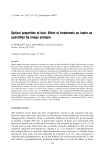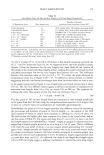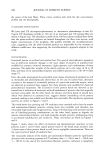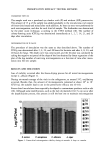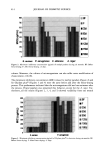LIGHT SCATTERING IN HAIR CUTICLES 361 a) 100%- 5O% - Surface /•. .... Bulk I I I b) 5 10 15 Relaxation times (min.) ß - . : - • • • 0 5 10 15 Relaxation times (min.) Figure 10. Variation in (a) moisture content in fiber surface compared to the bulk content, and (b) amount of glittering speckles as a function of the relaxation times. short period by relaxation in high humidity. The repeated applications of hair care cycles, shampooing, rinsing, blow-drying, etc., however, seem to cause several glittering speckles to become fixed. These speckles won't disappear even after wetting and using a natural drying process, especially at the tip part of the hair. Furthermore, it is considered that this harsh structural change will cause serious cuticle damage by other mechanical stresses, such as abrasion or combing force. Figure 13 shows microphotographs of the same part of a fiber surface before and after the blow-drying/combing process observed by optical and electron microscopes. The optical microscope images revealed that some of the cuticle cells had chipped away after comb- ing, selectively at the cuticles with glittering speckles (circled in Figure 13). Moreover, rough-surfaced residues at the same part of the fiber surface were shown through SEM observation where pieces of cuticle cell had been chipped away by combing. Through TEM observation of a longitudinal section (Figure 14), these rough-surfaced residues shown in the SEM image were revealed to be endocuticles. Figure 15 shows a possible mechanism for fracturing a cuticle edge with a glittering
362 JOURNAL OF COSMETIC SCIENCE o.3 o 0 • o • o o o 100% 50% 30 60 Relaxation times (min.) Figure l 1. Variation in moisture content in hair fiber (O) and amount of glittering speckles (O) upon relaxation in a high-humidity condition (75%/23øC). a) b) Figure 12. Optical microscope observations of hair fiber dried in silica-gel desiccator (a) just after being dried and (b) relaxing in a high-humidity (75% RH/23øC) condition. The analysis was performed on the same part of the hair fiber. patch by combing. First, (a) a cuticle cell is transformed by the blow-drying process, and (b) the exocuticle cracking occurs because the exocuticle, which is harder but brittlet than the endocuticle, doesn't comply with the combing force. Finally, (c) the endocuticle is torn by further combing force and the cuticle edge is chipped away. PROTECTION TECHNOLOGY OF HAIR CUTICLE DAMAGE The authors examined the suppression technology against generation of glittering speck-
Purchased for the exclusive use of nofirst nolast (unknown) From: SCC Media Library & Resource Center (library.scconline.org)















